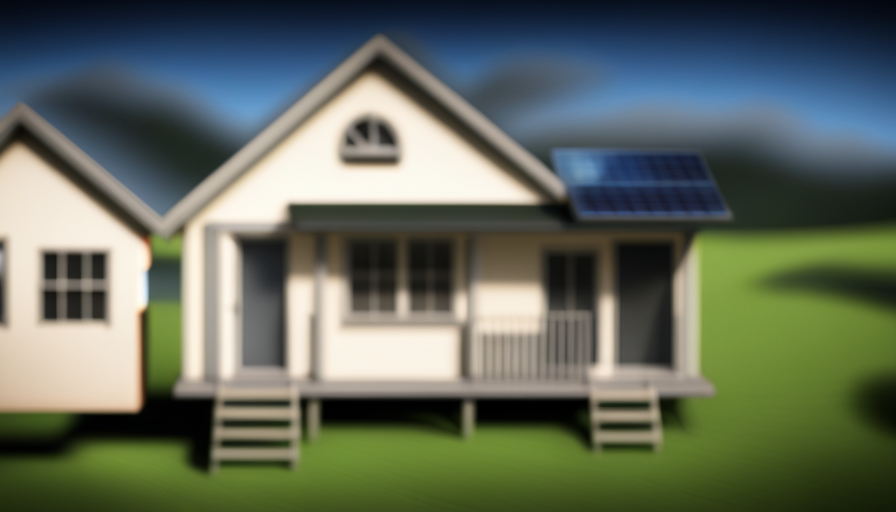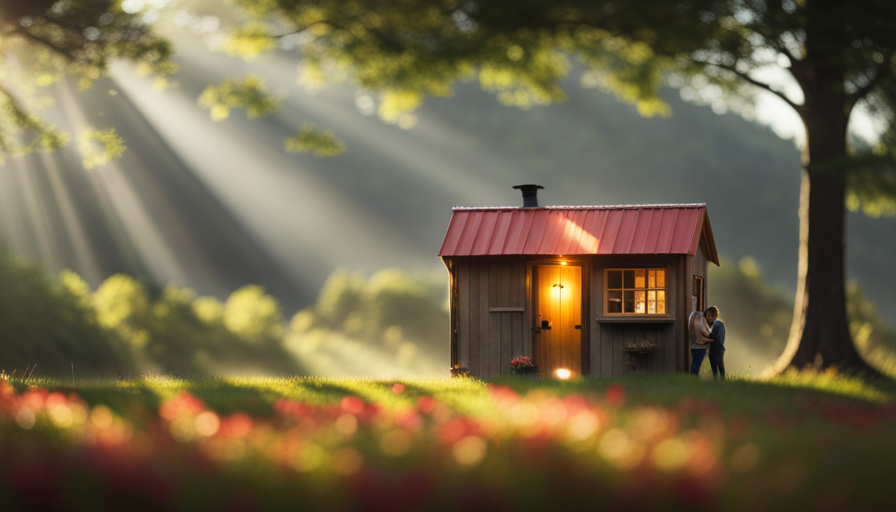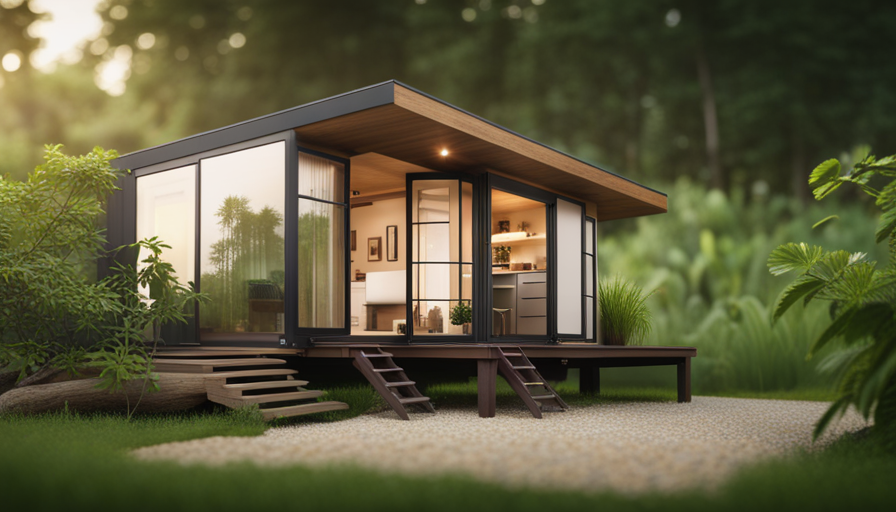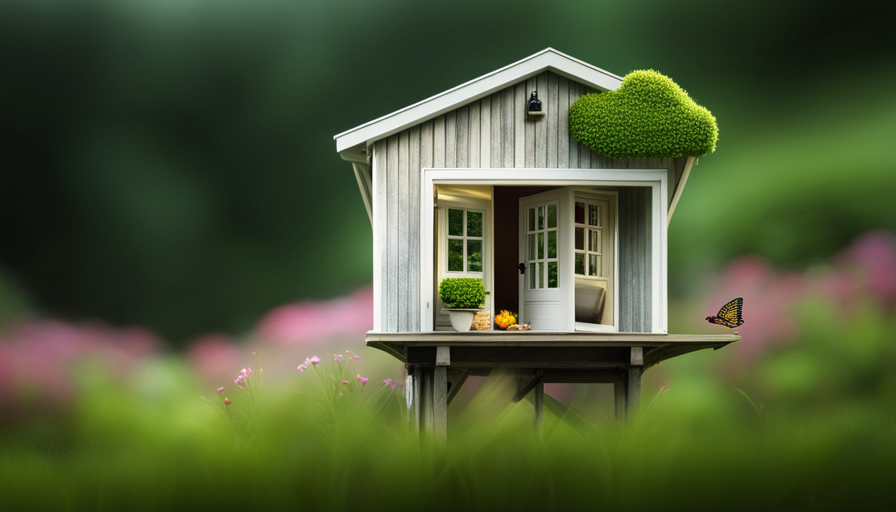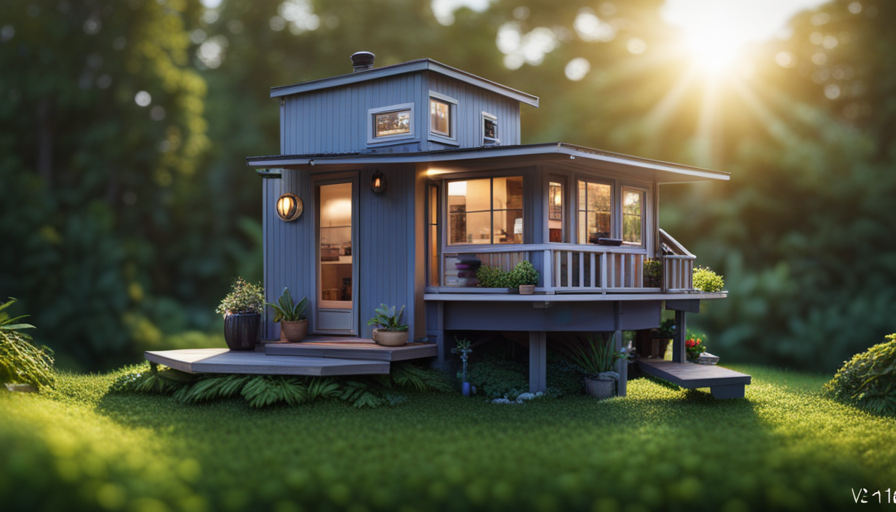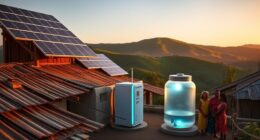By chance, as I began my quest to establish a self-reliant and eco-friendly way of life, I discovered the fascinating realm of tiny houses. These small homes present a distinctive chance to reduce our environmental impact and sustain a life disconnected from the conventional power grid.
However, powering a tiny house can be quite a challenge. That’s where solar power comes in. In this article, I will guide you through the intricate process of wiring a tiny house for solar power, enabling you to harness the unlimited energy of the sun.
We will start by assessing your power needs and calculating the size of your solar power system. Then, I will help you choose the ideal solar panels and determine the battery storage capacity required.
Next, we will delve into the installation of a solar charge controller and an inverter for AC power. I will also provide detailed instructions on wiring your tiny house for DC power.
Finally, we will discuss testing, monitoring, and maintaining your solar power system, as well as upgrading it to meet your evolving needs.
So, let’s embark on this electrifying journey towards a greener future!
Key Takeaways
- Assess power needs and calculate the size of the solar power system.
- Choose the right solar panels and battery storage capacity.
- Install a solar charge controller and inverter for AC power.
- Provide detailed instructions on wiring a tiny house for DC power.
Assess Your Power Needs
Now it’s time to figure out how much power you’ll need to keep your tiny house running smoothly on solar energy. Calculating energy consumption is crucial to ensure that your solar power system meets your needs.
Start by making a list of all the electrical appliances and devices you plan to use in your tiny house. Consider their power ratings and the average number of hours you’ll use them each day. This will help you determine the total energy consumption of your house.
Once you have this information, you can start optimizing power usage by choosing energy-efficient appliances and implementing energy-saving practices. By understanding your power needs and optimizing power usage, you can effectively design and install a solar power system that’ll meet your requirements.
Now let’s move on to calculating your solar power system size and ensuring it can meet your energy demands.
Calculate Your Solar Power System Size
To accurately determine the size of your solar system, you’ll need to calculate the amount of electricity needed to sustain your energy needs in your cozy abode. This step is crucial in ensuring that your solar power system is capable of meeting your requirements.
Here are three key factors to consider when calculating your solar power system size:
-
Solar power benefits: Understand the advantages of solar power, such as reduced electricity bills, lower carbon footprint, and potential financial incentives.
-
Solar power installation process: Familiarize yourself with the steps involved in installing a solar power system, including site assessment, panel placement, and connection to the electrical grid.
-
Evaluate your energy consumption: Determine your daily energy usage by analyzing your appliances, lights, and other electrical devices. Consider seasonal variations and the number of sunlight hours in your area.
By accurately calculating your energy needs and understanding the solar power benefits and installation process, you can now move on to choosing the right solar panels for your tiny house.
Choose the Right Solar Panels
When it comes to outfitting your cozy abode with the perfect solar solution, finding the right panels for your energy needs is key. The efficiency of solar panels is crucial in determining how much energy they can generate. Look for panels with high efficiency ratings to maximize power output.
Additionally, consider the placement of your solar panels. Ideally, they should be installed in a location that receives ample sunlight throughout the day, such as a south-facing roof. Avoid shading from trees, buildings, or other obstructions that can reduce the panels’ effectiveness. Proper placement ensures optimal sunlight exposure and increases overall energy production.
Moving forward to determining your battery storage capacity, it’s important to consider how much energy you want to store for later use.
Determine Your Battery Storage Capacity
Prepare to calculate the capacity of your battery to ensure you can store sufficient energy for later use. To optimize energy storage in your tiny house, follow these steps:
-
Determine your daily energy consumption by adding up the wattage of all your appliances and devices.
-
Calculate the number of days you want to rely on battery power during periods of low sunlight.
-
Multiply your daily energy consumption by the number of days to get your total energy requirement.
-
Divide the total energy requirement by the depth of discharge (DOD) of your battery to calculate the necessary battery capacity.
By accurately calculating your battery capacity, you can ensure that your tiny house has enough energy storage to meet your needs.
Now, let’s move on to the next step and learn how to install a solar charge controller.
Install a Solar Charge Controller
Once you’ve determined your battery storage capacity, it’s time to install the solar charge controller to ensure efficient energy management in your cozy abode. The solar charge controller plays a crucial role in regulating the flow of electricity from your solar panels to the batteries, preventing overcharging and ensuring optimal performance.
To begin, mount the controller in a well-ventilated area near your batteries, ensuring proper wiring connections. It’s essential to follow the manufacturer’s instructions for installation and to adhere to safety precautions.
Regular solar charge controller maintenance is necessary to keep it functioning optimally. This includes checking for loose connections, cleaning the controller regularly, and inspecting for any signs of damage.
Troubleshooting the solar charge controller involves identifying any error codes or abnormal behavior and addressing the issue accordingly.
With the solar charge controller installed and maintained, you’re now ready to connect your solar panels to the charge controller, maximizing the efficiency of your solar power system.
Connect Your Solar Panels to the Charge Controller
To ensure optimal performance, it’s crucial to connect your solar panels to the charge controller, effectively maximizing the efficiency of your renewable energy system. When connecting solar panels to the charge controller, it’s important to follow the manufacturer’s instructions and safety guidelines. To help you understand the process, here’s a table that outlines the basic steps:
| Solar Panel Connection | Charge Controller Connection | Troubleshooting |
|---|---|---|
| Connect positive wire from panel to positive terminal on controller | Connect negative wire from panel to negative terminal on controller | Check for loose connections |
| Connect positive wire from controller to battery’s positive terminal | Connect negative wire from controller to battery’s negative terminal | Test voltage output |
| Install appropriate fuses or breakers in between panels and controller | Ensure proper grounding of the system | Monitor system performance regularly |
By following these steps and troubleshooting any issues, you can ensure a successful connection of your solar panels to the charge controller. In the next section, we will discuss how to install an inverter for AC power.
Install an Inverter for AC Power
Now that you’ve successfully connected your solar panels to the charge controller, it’s time to bring your renewable energy system to life by installing the inverter. The inverter acts as the heart of your system, converting DC power from the batteries into AC power to energize your home like a beating heart powers the body.
When choosing the best inverter for your tiny house, consider the power requirements of your appliances and electronics. Look for an inverter that can handle the maximum power load you anticipate. It’s also important to consider the inverter’s efficiency, reliability, and warranty.
Once you have chosen the right inverter, carefully follow the manufacturer’s instructions to install it correctly. In case of any issues, such as the inverter not functioning properly or generating excessive heat, refer to the troubleshooting guide provided by the manufacturer.
With the inverter installed and functioning correctly, you are now ready to wire your tiny house for DC power, ensuring a seamless transition in your solar power system.
Wire Your Tiny House for DC Power
With the inverter humming and electricity flowing through your tiny sanctuary, your home glows with the gentle hum of renewable energy. One of the key benefits of using solar power in your tiny house is the ability to wire it for DC power. DC electrical wiring allows for a more efficient transfer of energy from the solar panels to your appliances and batteries. To properly wire your tiny house for DC power, you need to understand the basics of electrical circuits and safety precautions.
To help you visualize the process, refer to the table below:
| Component | Function |
|---|---|
| Solar Panels | Capture sunlight |
| Charge Controller | Regulates power flow |
| Batteries | Store excess energy |
| DC Load | Power appliances |
| Fuses | Protect against overloads |
By understanding the components and their functions, you can ensure a smooth and efficient wiring process for your tiny house. Now, let’s move on to the next section about testing and monitoring your solar power system.
Test and Monitor Your Solar Power System
Make sure you regularly test and monitor your solar power system to ensure it’s running smoothly and efficiently. Testing and monitoring the solar panel efficiency is crucial in order to identify any issues or problems that may arise.
One common issue to troubleshoot is a decrease in solar panel efficiency, which could be caused by shading, dirt, or damage to the panels. To test the efficiency, you can use a multimeter to measure the voltage and current output of the panels.
Additionally, monitoring the system’s performance over time can help identify any changes or potential problems. Keep an eye out for any noticeable drops in energy production or irregularities in the power flow.
By regularly testing and monitoring your solar power system, you can ensure it’s operating at its best and address any issues promptly.
Moving on to maintaining and upgrading your solar power system…
Maintain and Upgrade Your Solar Power System
Ensuring the optimal performance of your solar energy setup is like tending to a flourishing garden – regular maintenance and occasional upgrades will help your system thrive and continue to generate clean, renewable energy.
Here are three key steps to maintain and upgrade your solar power system:
-
Clean and inspect your solar panels regularly to maximize their efficiency. Remove dirt, debris, and snow, and check for any damage or loose connections that may affect performance.
-
Monitor your system’s performance using a solar power monitoring tool. This will help you identify any issues, such as low output or faulty components, and take prompt action to resolve them.
-
Stay informed about common solar power system issues and troubleshooting techniques. Familiarize yourself with common problems like inverter failures or shading issues, and learn how to address them effectively to ensure optimal performance.
By following these maintenance and troubleshooting practices, you can keep your solar power system operating at its best and enjoy the benefits of clean, renewable energy for years to come.
Frequently Asked Questions
What are the potential risks or dangers associated with wiring a tiny house for solar power?
Potential risks and dangers associated with wiring a tiny house for solar power include safety precautions, fire hazards, and electrical hazards. It’s important to take proper safety measures when working with solar power systems to prevent accidents and damage.
Safety precautions such as using the correct wiring methods, installing circuit breakers, and grounding the system can help minimize the risks. Fire hazards may arise from faulty wiring or improper installation, while electrical hazards can occur if the system isn’t properly grounded or if there’s a malfunction.
Can I connect multiple tiny houses to one solar power system?
Sure, you can connect multiple tiny houses to one solar power system. It offers numerous benefits like cost savings, environmental friendliness, and energy independence.
By interconnecting the houses, you can share the generated solar energy, reducing the need for individual systems. This allows for more efficient energy usage and lowers the overall installation and maintenance costs.
It’s a smart and sustainable solution for powering multiple tiny houses with clean, renewable energy.
How long does the installation process typically take for wiring a tiny house for solar power?
The installation time for wiring a tiny house for solar power can vary depending on several factors. However, on average, the process typically takes around 2-3 days to complete.
It’s important to note that this timeframe can be affected by common pitfalls such as improper planning, lack of experience, or unexpected complications. To ensure a smooth installation, it’s recommended to thoroughly research and consult with professionals before beginning the project.
Are there any specific building codes or regulations that need to be followed when wiring a tiny house for solar power?
When wiring a tiny house for solar power, it’s crucial to adhere to specific building codes, regulations, and electrical standards. These measures ensure compliance and safety during the installation process. Building codes may dictate the type of wiring, grounding requirements, and placement of electrical components.
Electrical standards provide guidelines for properly sizing and installing solar panels, inverters, and batteries. By following these regulations, you can ensure a safe and efficient solar power system for your tiny house.
How much maintenance is required for a solar power system in a tiny house, and what are the associated costs?
When it comes to the maintenance of a solar power system in a tiny house, regular upkeep is necessary to ensure optimal performance. This includes cleaning the solar panels to remove any dirt or debris that may hinder their efficiency.
Additionally, the battery bank should be regularly checked for proper functioning and replaced if needed.
As for costs, regular maintenance expenses may include cleaning supplies, battery replacements, and occasional professional inspections, which can vary depending on the specific system and its components.
Conclusion
In conclusion, wiring a tiny house for solar power is a meticulous process that requires careful planning and consideration of various factors. By assessing your power needs and calculating the system size, you can determine the right solar panels and battery storage capacity.
Installing a solar charge controller and inverter for AC power is essential, followed by wiring your tiny house for DC power. Testing and monitoring the system is crucial, and regular maintenance and upgrades will ensure optimal performance.
Embracing this sustainable power solution opens the door to a greener and more self-sufficient lifestyle.
Hi, I’m Emma. I’m the Editor in Chief of Tiny House 43, a blog all about tiny houses. While tree houses are often associated with childhood, they can be the perfect adult retreat. They offer a cozy space to relax and unwind, surrounded by nature. And since they’re typically built on stilts or raised platforms, they offer stunning views that traditional homes simply can’t match. If you’re looking for a unique and romantic getaway, a tree house tiny house might just be the perfect option.
